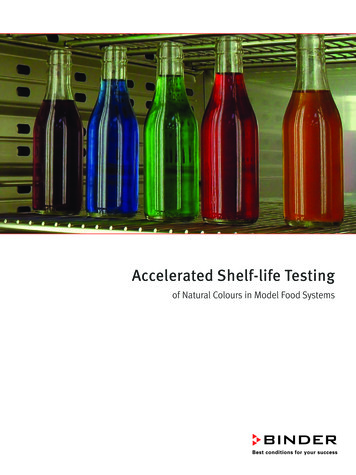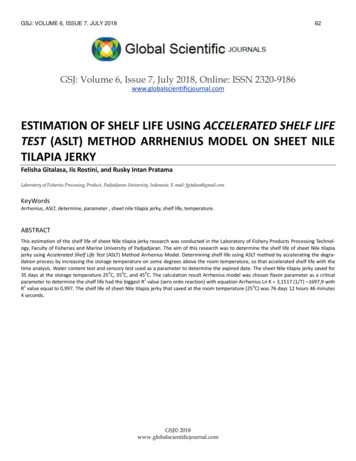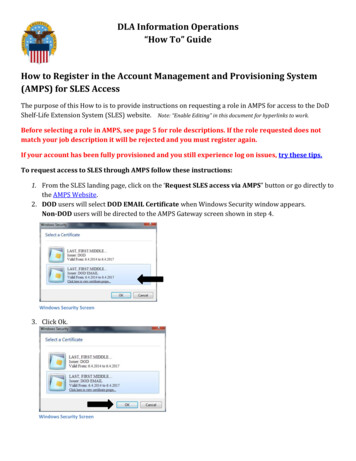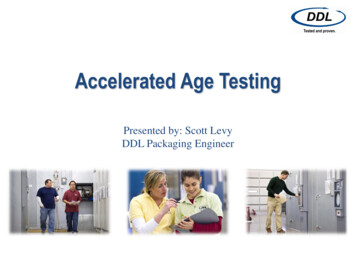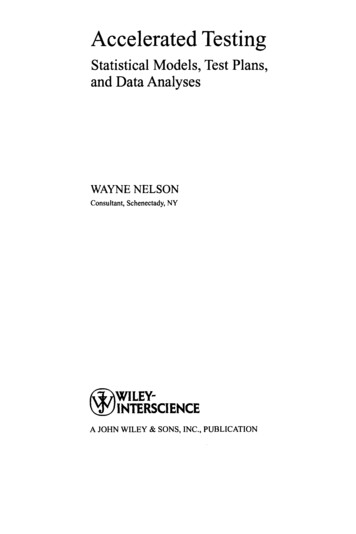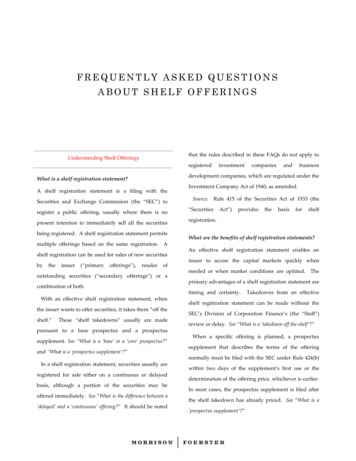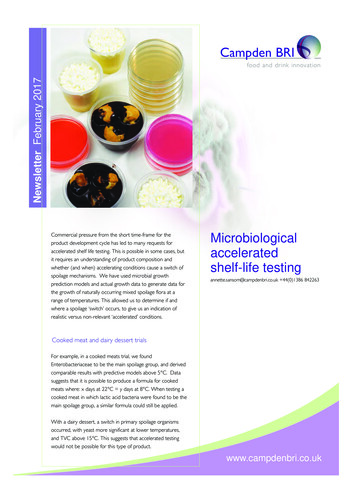
Transcription
Newsletter Feb2017 Newsletter 24/01/2017 16:33 Page 1Campden BRINewsletter February 2017food and drink innovationCommercial pressure from the short time-frame for theproduct development cycle has led to many requests foraccelerated shelf life testing. This is possible in some cases, butit requires an understanding of product composition andwhether (and when) accelerating conditions cause a switch ofspoilage mechanisms. We have used microbial growthprediction models and actual growth data to generate data forthe growth of naturally occurring mixed spoilage flora at arange of temperatures. This allowed us to determine if andwhere a spoilage ‘switch’ occurs, to give us an indication ofrealistic versus non-relevant ‘accelerated’ conditions.Microbiologicalacceleratedshelf-life testingannette.sansom@campdenbri.co.uk 44(0)1386 842263Cooked meat and dairy dessert trialsFor example, in a cooked meats trial, we foundEnterobacteriaceae to be the main spoilage group, and derivedcomparable results with predictive models above 5 C. Datasuggests that it is possible to produce a formula for cookedmeats where: x days at 22 C y days at 8 C. When testing acooked meat in which lactic acid bacteria were found to be themain spoilage group, a similar formula could still be applied.With a dairy dessert, a switch in primary spoilage organismsoccurred, with yeast more significant at lower temperatures,and TVC above 15 C. This suggests that accelerated testingwould not be possible for this type of product.www.campdenbri.co.uk
Newsletter Feb2017 Newsletter 24/01/2017 16:33 Page 2Supporting food authenticity2Authenticity assurance remains one of the biggest challenges currently faced by the food and drink industry. Therecommendations of the Elliott Report and compliance with BRC’s Global Food Safety Standard (version 7) has ledto a requirement for companies to perform vulnerability studies and risk assessments, and in certain circumstancestest the authenticity of raw materials and ingredients. Our extensive experience in authenticity issues and state-ofthe-art laboratories allow us to support our clients. We are working with our members and clients to help addressthe issue of authenticity through our technical services, research and strong industrial links.We are proud to be recognised as a UK Centre of Excellence in food authenticity testing by defra. We carry outolive oil grade testing for the Rural Payments Agency to ensure the authenticity of olive oil imported into the UK. Forthe past 13 years we have been scientific analysts for HM Revenues and Customs (HMRC) carrying out analysis ofgoods imported into the UK from outside the EU. We were pleased to be chosen to provide technical andadministrative support to the Food Industry Intelligence Network (FIIN) last month (see page 3).Steven Walker, Director GeneralEmerging ingredients - considerationsfor use in products (Member funded research project)Ingredient insight factsheets are a new addition to the project redients.php1 Chia seeds (Salvia hispanica)2 InsectsAlso see the Chia seeds article on page 7.Switch channelLinkedIn - company newswww.linkedin.com/company/campden-briYouTube - videos on the science andtechnology of food and drink productionwww.youtube.com/campdenbriTwitter - keep up to date with our latestnews and activitieshttps://twitter.com/campdenbriiTunes - subscribe to our podcastsFacebook - find out about our historyand lighter sidewww.facebook.com/campdenbripage
Newsletter Feb2017 Newsletter 24/01/2017 16:33 Page 3Services3Supporting industry infight against food fraudWe are delighted to have been chosen to providetechnical and administrative support to the Food IndustryIntelligence Network (FIIN).We will curate a database for FIIN to collect anonymised(via legal host) industry data on food authenticity testing.We will analyse the data and produce regular reports forthe FIIN members. We will also be responsible formanaging the FIIN membership and organising FIINevents.FIIN is an important industry network addressing animportant industry issue. We are pleased to be helpingits members in proactively addressing the issue of foodand drink fraud. If you are interested in joining FIIN,please contact FIIN@campdenbri.co.ukOut and about - atPackaging InnovationsWe will be playing a major role at the PackagingInnovation exhibition at the NEC, Birmingham on1-2 March. Come and visit us at Stand J48 – where arolling programme of packaging videos will be shownthroughout the day.The Campden BRI mini-theatre on the stand will featurepresentations on: The role of packaging in optimising quality EU food contact materials rules Understanding migration testing Food packaging: shape, colour and textureCreating a tasty burgerwith increased fibrephilip.richardson@campdenbri.co.uk 44(0)1386 842036We were challenged as part of a project for the Food &Health Innovation Service (FHIS) to reformulate economybeef burgers to make them ‘healthier’. Our aim was toreduce the sodium (salt) content of beef burgers whileadding beta-glucan (soluble fibre).Economy beef burgers contain fillers as a bulking agent.Whilst fillers can help manage the cost of the burger, theyalso provide an opportunity to re-formulate the nutritionalcontent. We created three variations of the economy beefburger using three fillers to replace low fibre rusk filler: finemilled oat bran, milled oats or ground quick oats . The threereformulated beef burgers contained almost a third lesssodium than the ordinary economy burger, meeting thetarget set by the Department of Health for 2017.The burgers made with oat bran filler retained moisture bestand had a similar cook loss to the ordinary economy burger.Informal tastings showed that the beef burgers containing oatbran filler were also preferred to the ordinary economyburger.The work showed that substituting rusk filler in economybeef burgers with oat bran filler produced a burger thatcontained less sodium and more fibre, and crucially had apreferred taste to an ordinary economy burger.
Newsletter Feb2017 Newsletter 24/01/2017 16:33 Page 44Food structureand image analysisalix.cornish@campdenbri.co.uk 44(0)1386 842054Many foods and food materials have a non-uniformstructure and composition. They may contain bubbles,emulsions, multiple components such as fruit pieces inyoghurt, structures such as marbling fat in meat, orgradients of fat, water or salt.As well as measurements of average composition,aspects of the structure, appearance and distributionof components are also important. There are severaltechniques available to study these - and we areleaders in this field. Measurements can be used, forexample to document appearance, to check thatingredients are uniformly dispersed or to study changesin colour or migration of components over shelf life.Colour and appearanceThe colour and appearance of food products arecritical for customer acceptance. Colour meters andspectrophotometers provide accurate measurementsfor uniform products. For more complex products orto aid interpretation and communication ofappearance, digital images are also used. Calibratedimaging systems using controlled imaging conditions andcolour reference standards enable accurate colourreproduction to be achieved for digital and printedimages. Images can be analysed to discriminate featuressuch as lean meat and marbelling fat and to measure thecolour of specific regions of interest.Structure characterisationX-ray micro-tomography is a powerful technique forcharacterising product structure, enabling the internalstructure of samples to be scanned non-destructively in3D at resolutions as small as 1 micrometre. The resultingimages can be studied interactively on a computer screenwithout any destructive sample preparation andmeasurements can be made of properties such as bubblesize distributions and internal product dimensions.Applications include characterisation of porous structures
Newsletter Feb2017 Newsletter 24/01/2017 16:33 Page 55Foodrheologysarab.sahi@campdenbri.co.uk 44(0)1386 842140such as snacks, baked products and confectionery, andnon-destructive investigation of problems such as leaks inplastic closures, or foreign bodies.Optical and scanning electron microscopy methods arealso useful for characterisation of product structure,particularly for high magnification work. These can beused in combination with techniques that provide furtherinformation on the structures imaged, including X-rayspectroscopy to identify elemental composition.Compositional mappingImaging at non-visible wavelengths can provideinformation on product composition. A hyperspectralnear infrared imaging system measures an NIR spectrumfor each pixel in an image, enabling the distribution ofcompounds such as fat and moisture to be measured.Following calibration for a given product application, rapidquantitative measurements can then be made for testsamples, including at-line measurements. Applicationsinclude mapping of moisture distributions, for example tostudy uniformity of baking processes, or to study moisturemigration between product components during storage.These techniques offer solutions for a diverse range ofproblems. Please get in touch to discuss yourrequirements.The rheological properties of food materials areimportant in determining both texture and behaviourwhen subjected to physical forces and forced to flow.Here are four examples of how we can study therheological properties of raw materials, intermediateproducts such as batters and doughs, and final products.Oscillation: a small deformation is applied and theresponse measured, while maintaining the integrityof the test material. This provides insight into thestructural properties of the material and the likelystability over time.Viscosity: Rapid Visco Analysis measures the viscositybuild up of starch-based materials as they are heated.The rate of heating and degree of shear force on theviscosity of the material can be measured as can theeffect of salt, emulsifiers, enzymes and other materials.Drop shape analysis: surface or interfacial propertiesplay an important role in foam and emulsion creationand stability. The wetting behaviour of a liquid when incontact with a solid surface can be determined bymaking contact angle measurements.Flow measurements: the distance a sample flows in agiven time indicates the consistency of products such assauces, purees, salad dressings, and batters.
Newsletter Feb2017 Newsletter 24/01/2017 16:33 Page 66SeminarsMicrobiological criteria ffs.phpTraining eventsA full list of scheduled courses is available on our websitewww.campdenbri.co.uk/training.php or request a bookletfrom training@campdenbri.co.uk 44(0)1386 842104March -3029-30Understanding microbiologyUSA food and drink labelling courseHACCP - advanced (level 4)Internal auditing - principles and practicesMicrobiological criteria for foodstuffsHACCP - intermediate (level 3)Gluten free conferencePackaging hazardsSafe production of dried foodFood safety - advanced (level 4)Practical microbiology - advancedFood processing hygiene management(course in 2 modules)FSPCA preventive controls for human foodAn introduction to food lawwww.campdenbri.co.uk/training.phpWill cover the importance of microbiological criteria,and a description and demonstration of our newsearchable database, along with an update on theassociated microbiological criteria guideline and newguidance on sampling for microbiological hazards.Packaging hazards 21 Marchat the pro2pac exhibition at the ExceL, like food and drink hazards, those associated withpackaging are less well documented and may not beconsidered; however, they can affect the safety andquality of the product. Identification of potentialpackaging hazards, migration testing, packagingdecontamination, and the use of HACCP will bediscussed.Safe production of dried foods24 hpAlthough traditionally thought of as stable from amicrobiological point of view, dried foods can still becontaminated, and survival of organisms is possible,even in tough conditions. It is important to understandnot only the risks of microbial contamination andcontrol methods, but also non–microbial issues such asallergens and foreign bodies.
Newsletter Feb2017 Newsletter 24/01/2017 16:33 Page 7Member zonewww.campdenbri.co.uk/memberzone.phpto access privileged memberinformation and services7Welcometo new membersWe are delighted to welcome the following new members:AllinAll Ingredients - ingredient blenderBritish Airways - airlineDaily Bake Ltd - manufacturer of pies, ready meals, sauces, soups,puddings and pastryFarmHouse Biscuits Ltd - manufacturer of sweet and savoury biscuitsFlower of Life Limited - brewer of Kombucha, a fermented green teaImspex Diagnostics Ltd - manufacturer of gas chromatography ionmobility systemsNiacet BV - producer of organic acid salt powders for food,pharmaceutical and technical applicationsPip & Nut Ltd - manufacturer of nut buttersSarant Ltd - producer of honey, seasonings and soup powdersSherriffs Foods - trader in gluten-free productsClare Brett 44(0)1386 842125 membership@campdenbri.co.ukPlease notify the Membership Department of any name or addresschanges to allow us to keep our records up to date.Catch up on webinarsHave you missed a recent Campden BRI webinar? Are youlooking for another quick and easy way to discover some ofour latest research findings? Our website now allows you toaccess our recorded webinar content, including topicalpresentations and member funded project updates. Highlightsso far include benefits of membership, TACCP andpresentations on cereal testing, online sensors and super chilling(further recordings will be added as they are produced).Dates and times for live webinars aren’t alway
accelerated shelf-life testing annette.sansom@campdenbri.co.uk 44(0)1386 842263 Commercial pressure from the short time-frame for the product development cycle has led to many requests for accelerated shelf life testing. This is possible in some cases, but it
